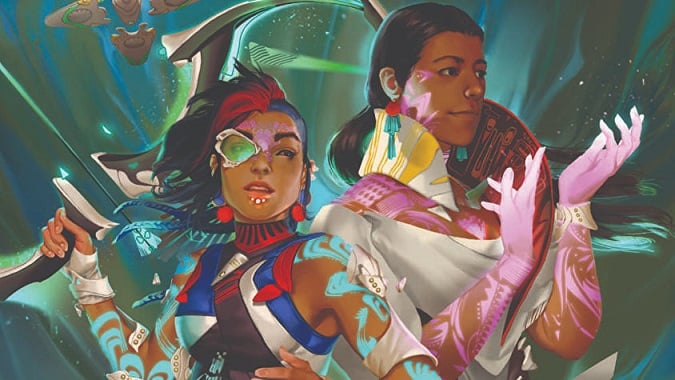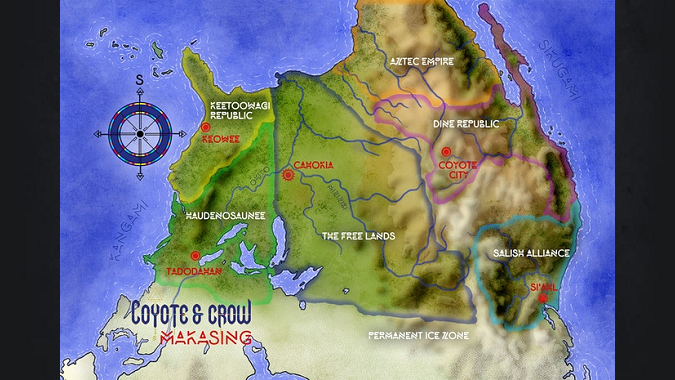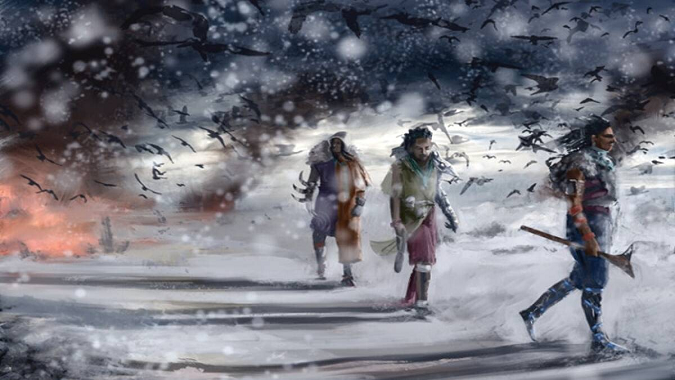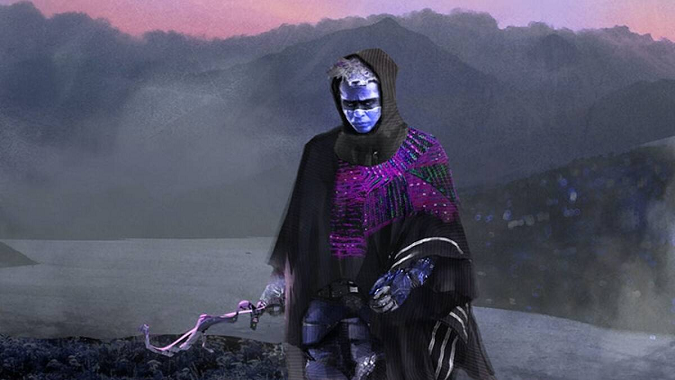Coyote & Crow is a science fantasy TTRPG that imagines an uncolonized Western Hemisphere

Coyote & Crow is a science fantasy TTRPG that was overwhelmingly successful on Kickstarter last year, nominated for a Nebula award for Game Writing, and is now appearing on the shelves of your local gaming store. Set on the North American continent (known as Makasing in-game), C&C imagines what would’ve happened if colonization of the Western Hemisphere had not occurred, due to a calamity that wreaked global devastation and triggered a significant ice age over the past several centuries that is now starting to retreat. The result is an Indigenous society that combines rapidly-emerging technology — 3D printers are standard in almost every household — with more traditional beliefs and skills.
What makes Coyote & Crow so intriguing is its creation and development by a diverse Indigenous-led team incorporating members from more than a dozen tribes. This is not your typical appropriation of culture that has too often occurred in the TTRPG space these past few decades, but instead an attempt to create a world that is consistent with their own. To ensure that non-Natives — who are of course welcome and encouraged to play in this world — don’t engage in any accidental appropriation, there are guidelines in place for Natives and non-Natives. An example is the use of real world tribes — a member of Cherokee Nation can choose them as their character’s background tribe, but a non-Cherokee should not.

Exploring Makasing and Cahokia
The lands of Coyote & Crow are home to 12 nations, of which 5 are located in Makasing — the Ezcan Empire (originally called Aztec, which is why it is labeled as such in the image above) is considered part of the Mesoamerican-equivalent Azayang region — and the central focus of the core rulebook is on the Free Lands and the sovereign city-state of Cahokia. While the real world version of Cahokia flourished earlier last millennium, in C&C it has grown up again in the aftermath of the calamity. Now home to over 2 million people, Cahokia is the largest city in the known world and the perfect place to start your adventures.
Within Cahokia you’ll experience both the science and the fantasy aspects of C&C, as both are present in abundance. Besides the aforementioned 3D printers, you’ll see citizens sporting personal computer devices on their wrists and tech goggles over their eyes while they travel around town on maglev vehicles. At the same time there are still plenty of elements of a fantasy setting present, with only some weapons using modern technology — axes are still a popular melee weapon choice — and abilities tend to mimic those familiar to Dungeons and Dragons and Pathfinder players, with herbs being picked for medicinal purposes, and players tapping into spiritual forces to overcome their opponents. While there is no magic currently in the setting, there are many mind-based abilities akin to psionics.
The opposition your characters may face are also a blend of science and fantasy, as they range from human to animal — my favorite of these are the race of intelligent Wooly Mammoths — to spirits pulled from Native mythology. Unlike most other TTRPGs the entries in the bestiary for C&C are presented as challenges that engage your characters in a multitude of ways, and the solution is rarely, “hit it with weapons until it stops moving.” Instead they could be stories that motivate the direction of an adventure, allies that assist you along your way, or vague shadows that seem to be following the players but never interact with them.

Narrative choices and rolling dice: the Coyote & Crow system
Like other modern TTRPG systems, Coyote & Crow is built around the players’ narrative choices. The goal of the Story Guide (C&C‘s version of the GM) is to present options and, well, Guide the Story. The core concept for these choices is known as “Three Path”, namely the Story Guide prepares and sometimes presents (depending on the experience of the players) three options for a given encounter — for example, the players can attempt to charm their opponents, intimidate them, or fight them. This is not to say that there shouldn’t be more options determined by the Story Guide or players, but by focusing on three possible ways to complete an encounter the Story Guide should be able to handle deviations adroitly.
Because the Story Guide is so integral to the gaming process in C&C it’s advisable that if an inexperienced game manager is the Story Guide that they take plenty of time to familiarize themselves with the setting and mechanics because it’s complicated even for a veteran player. Fortunately, there is an effective “rules light” adventure available for introducing both Story Guides and players to the game, and it does an excellent job of providing a feel for the setting — although it does use a lighter encounter system, so don’t get attached to the six-sided dice used in it.
The encounter system for C&C is built around d12 dice and the number of successes you roll. Based on what a player is attempting and what their skills are, they’ll roll multiple dice and count the number of successes to determine the impact. An example would be attempting to pick a lock; a roll above 8 on a d12 is considered a success, and the lock might be complex enough that it requires four successes to bypass. A player may have enough relevant skill points that they can roll 4 or 5 dice in an attempt and every success gets them closer to removing the lock. If you don’t have enough d12 dice at home, you’ll be able to pick up branded dice next month online or at your local gaming shop, or you can use the Coyote & Crow companion app available from Google and Apple, which includes a d12 mode. Another option is to just roll two d6s scrounged from Monopoly and add them together.
The method is the same for combat; a success is essentially a hit against the opponent, and the number of successes is equal to the amount of damage done. So being skilled in what is being attempted not only makes success more likely, it could mean a quicker resolution, and thus the difference between overall success or failure. The mechanics can be a lot more complex than this — critical successes and failures are possibilities, and there can be modifiers to individual rolls — but this is the system at its core.

Crafting your hero
When creating your character in Coyote & Crow it’s important to keep in mind not only how you expect your hero to act, but also what they have done in the past and what their goals are for the future. To emphasize this, the first step in character creation is choosing their Motivation — are they seeking revenge for a past injustice, or do they wish to be a hero of the people? Do they believe that there is a great destiny awaiting them, or are they simply striving to bring order to the world? This Motivation can be used by the players and the Story Guide to help develop and evolve the adventure as it progresses.
Besides the standard traits such as age and gender, C&C uses three other characteristics to help flesh out the hero. The first of these is Archetype, consisting of six categories that are designed to suggest the character’s background without limiting their role — someone with the Healer Archetype is still capable of wielding a weapon, and it may even be their primary task in the group to fight when confrontations become violent. There is also the Path, an immutable choice that defines the core of your character. Each of the 15 Paths are named after an animal — Deer, Owl, Snake — and help determine the stats and abilities appropriate for the hero. Finally, characters are encouraged to take Gifts and Burdens that take aspects from their lives and impact how they react to the world.
Stats are similar to other TTRPGs, with 9 attributes — three physical (Strength, Agility, Endurance), three mental (Intelligence, Perception, Wisdom), and three spiritual (Spirit, Charisma, Will) — that are used alongside your Skills to determine outcomes. In addition, they are used to calculate other stats that your character uses; for example, Body (akin to Hit Points in other TTRPGs) is a summation of your physical attributes, not the result of a die roll.
What your character can do both in and out of encounters are defined by Skills and Abilities. The former is your typical range of tasks, from Medicine to Computers, Melee Weapons to Cooking, that are used at-will during the adventure to accomplish goals. Abilities are more limited in usage but are also more powerful; they include increasing an attribute for better attacks or protection, launching a mental attack at opponents or healing allies, or increasing perception or empathy in order to overcome the challenge. Most Abilities can only be used a certain number of times between Rests, and as most characters only possess the one Ability to use, they need to be judicious about activating them.
The final step for character building is defining their short-term and long-term goals with the assistance of the Story Guide. In lieu of levels and experience, the goals are milestones used for improving the character and making them better able to handle challenges and sometimes even driving the adventure. A character can have two short-term goals at any time, and they usually revolve around gaining or improving a skill, or acquiring an item that their (lack of) wealth makes them otherwise unable to obtain. Players work with the Story Guide to help determine the best way to compete a short-term goal, and it’s something that may be accomplished in as little as one play session, presuming the resources are available to help complete the goal — a hero isn’t likely to improve their Animal Husbandry skill if they spend the entire night in the computer room trying to fend off hackers. Long-term goals are more about improving the character for all situations, and the length of time required is typically measures in sessions; only one can be worked on at a time, and examples include increasing a stat, gaining a new Gift (or removing a Burden), or even acquiring a new Ability.
The world of Coyote & Crow is a compelling one, fusing past and future into an enchanting narrative that illuminates and celebrates Native culture and ideas through a Science Fantasy. This was a labor of love for the creators, and it shines through with the depth and care given to the setting. I’m looking forward to spending more time in Cahokia and the Free Lands, and can’t wait for the promised future expansions into the other Nations of Makasing.
Please consider supporting our Patreon!
Join the Discussion
Blizzard Watch is a safe space for all readers. By leaving comments on this site you agree to follow our commenting and community guidelines.
 @Kalcheus
@Kalcheus




